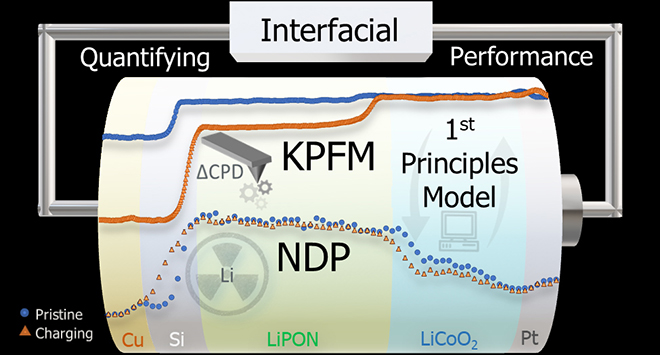Scientists at Sandia National Laboratories may have discovered a way to make a longer-lasting, more efficient battery. The team used Kelvin probe force microscopy to locate places where electron flows get stuck.
Solid-state batteries use solid electrolytes instead of electrochemical gels and liquids. Researchers suspected that there was a loss of voltage at interfaces within the battery, but didn’t know which interface was responsible for most of the impedance.
The group turned to Kelvin probe force microscopy, which measures electrical potential on a surface, and found that a large part of the electrical potential of the battery was getting lost at the boundary between the electrolyte and the anode terminal.
“The voltage between battery electrodes is relatively straightforward for researchers to calculate and measure,” said Battery Scientist Elliot Fuller. “However, where that voltage drops within the battery layers has remained a mystery. It’s critical to understand where the voltage drops, as it is intimately tied to the performance-limiting resistances. Kelvin probe force microscopy is a technique that finally enabled us to measure where these drops are occurring.”
“This technique has been used for many years to measure local voltage, with people using it on parts of a battery. It was difficult to interpret because it was not a full functioning battery,” said Sandia scientist Alec Talin. “We cut the battery in half longitudinally, with the elements stacked like a layer cake. You can still charge it and discharge it, so we did this measurement over the entire battery. Most people thought the biggest change was going to happen at the interface between the cathode and electrolyte. Understanding the measurements took a lot of time. We wanted to validate the data by measuring where the lithium ions were at different states during charging.”
To accomplish this, the team worked with researchers at the National Institute of Standards and Technology Center for Neutron Research using a technique called neutron depth profiling (NDP) that can measure where lithium ions are at a particular moment. Now that NDP has confirmed the Kelvin probe force microscopy data, the team is looking to apply this methodology to a host of technologies.
“We’re going to use this technique to look at other batteries as well as other solid-state electrical systems,” Talin said. “There were two main motivations for this. The first was fundamental: we want to have good models for batteries that we can use to develop better materials. The second thing was to figure out how we can engineer the interfaces to make them less impeding. In our case, it really has to do a lot with how fast lithium ions can move in the Si anode used in the study.”
Source: Sandia National Laboratories
